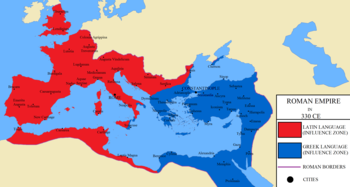
- "We're going to get naked" ([N]os nudi [f]iemus)
– "We came to drink" (Bibere venimus)
- "Now you're talking a lot" (Ia[m] multu[m] loquimini)
- "We may be called away" (Avocemur)
- "We're having three" [drinks] (Nos tres tenemus)
The scene may convey a proverbial expression equivalent to both "Let sleeping dogs lie" and "Eat, drink, and be merry, for tomorrow we may die."[1]
Latin and Greek were the dominant languages of the Roman Empire, but other languages were regionally important. Latin was the original language of the Romans and remained the language of imperial administration, legislation, and the military throughout the classical period.[2] In the West, it became the lingua franca and came to be used for even local administration of the cities including the law courts.[3][4] After all freeborn inhabitants of the Empire were granted universal citizenship in 212 AD, a great number of Roman citizens would have lacked Latin, though they were expected to acquire at least a token knowledge, and Latin remained a marker of "Romanness".[5]

Koine Greek had become a shared language around the eastern Mediterranean and into Asia Minor as a consequence of the conquests of Alexander the Great.[6] The "linguistic frontier" dividing the Latin West and the Greek East passed through the Balkan Peninsula.[7] Educated Romans, particularly those of the ruling elite, studied and often achieved a high degree of fluency in Greek, which was useful for diplomatic communications in the East even beyond the borders of the Empire. The international use of Greek was one condition that enabled the spread of Christianity, as indicated for example by the choice of Greek as the language of the New Testament in the Bible[8] and its use for the ecumenical councils of the Christian Roman Empire rather than Latin. With the dissolution of the Empire in the West, Greek became the more dominant language of the Roman Empire in the East, later referred to as the Byzantine Empire.
Because communication in ancient society was predominantly oral, it can be difficult to determine the extent to which regional or local languages continued to be spoken or used for other purposes under Roman rule. Some evidence exists in inscriptions, or in references in Greek and Roman texts to other languages and the need for interpreters. For Punic, Coptic, and Aramaic or Syriac, a significant amount of epigraphy or literature survives.[9] The Palaeo-Balkan languages came into contact with Latin after the Roman expansion in the Adriatic Sea in the 2nd century BC. Of the ancient Balkan languages, aside from Greek, only the precursor of Albanian survived in the Western Balkans, reflecting different chronological layers of Latin influence through contact during the entire period of spoken Latin in the region.[10]
The Celtic languages were widespread throughout much of western Europe, and while the orality of Celtic education left scant written records,[11] Celtic epigraphy is limited in quantity but not rare.[12] The Germanic languages of the Empire have left next to no inscriptions or texts, with the exception of Gothic.[13] Multilingualism contributed to the "cultural triangulation" by means of which an individual who was neither Greek nor Roman might construct an identity through the processes of Romanization and Hellenization.[14]
After the decentralization of political power in late antiquity, Latin developed locally in the Western provinces into branches that became the Romance languages, including Spanish, Portuguese, French, Italian, Catalan, Occitan, Aromanian and Romanian. By the early 21st century, the first or second language of more than a billion people derived from Latin.[15] Latin itself remained an international medium of expression for diplomacy and for intellectual developments identified with Renaissance humanism up to the 17th century, and for law and the Roman Catholic Church to the present.
- ^ Richard Brilliant, "Scenic Representations," in Age of Spirituality: Late Antique and Early Christian Art, Third to Seventh Century (Metropolitan Museum of Art, 1979), pp. 96–97.
- ^ Bruno Rochette, "Language Policies in the Roman Republic and Empire," translated by James Clackson, in A Companion to the Latin Language (Blackwell, 2011), p. 560.
- ^ Alex Mullen, "Introduction: Multiple Languages, Multiple Identities," in Multilingualism in the Graeco-Roman Worlds (Cambridge University Press, 2012), p. 28.
- ^ Rochette, "Language Policies in the Roman Republic and Empire," pp. 554, 556.
- ^ J.N. Adams, "Romanitas and the Latin Language," Classical Quarterly 53.1 (2003), pp. 185–186, 205.
- ^ Fergus Millar, A Greek Roman Empire: Power and Belief under Theodosius II (408–450) (University of California Press, 2006), p. 279; Warren Treadgold, A History of the Byzantine State and Society (Stanford University Press, 1997), p. 5.
- ^ Rochette, "Language Policies in the Roman Republic and Empire," p. 553.
- ^ Treadgold, A History of the Byzantine State, p. 5.
- ^ The Oxford Handbook of the Literatures of the Roman Empire, edited by Daniel L. Selden and Phiroze Vasunia (Oxford University Press). Richard Valantasis, introduction to Religions of Late Antiquity in Practice (Princeton University Press, 2000), p. 11.
- ^ Mallory & Adams 1997, pp. 9, 11; Fortson 2010, p. 448; Matzinger 2018, pp. 1791–1792; De Vaan 2018, p. 1732; Fischer & Schmitt 2022, p. 16.
- ^ MacMullen, "Provincial Languages in the Roman Empire," pp. 15–16.
- ^ Joseph Eska, "Inscriptions in the Celtic World," in Celtic Culture: A Historical Encyclopedia (ABC-Clio, 2006), pp. 965–970.
- ^ Tore Janson, A Natural History of Latin (Oxford University Press, 2004), p. 87.
- ^ Mullen, Southern Gaul and the Mediterranean, pp. 264–265.
- ^ James Clackson, introduction to A Companion to the Latin Language, p. 1.